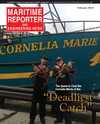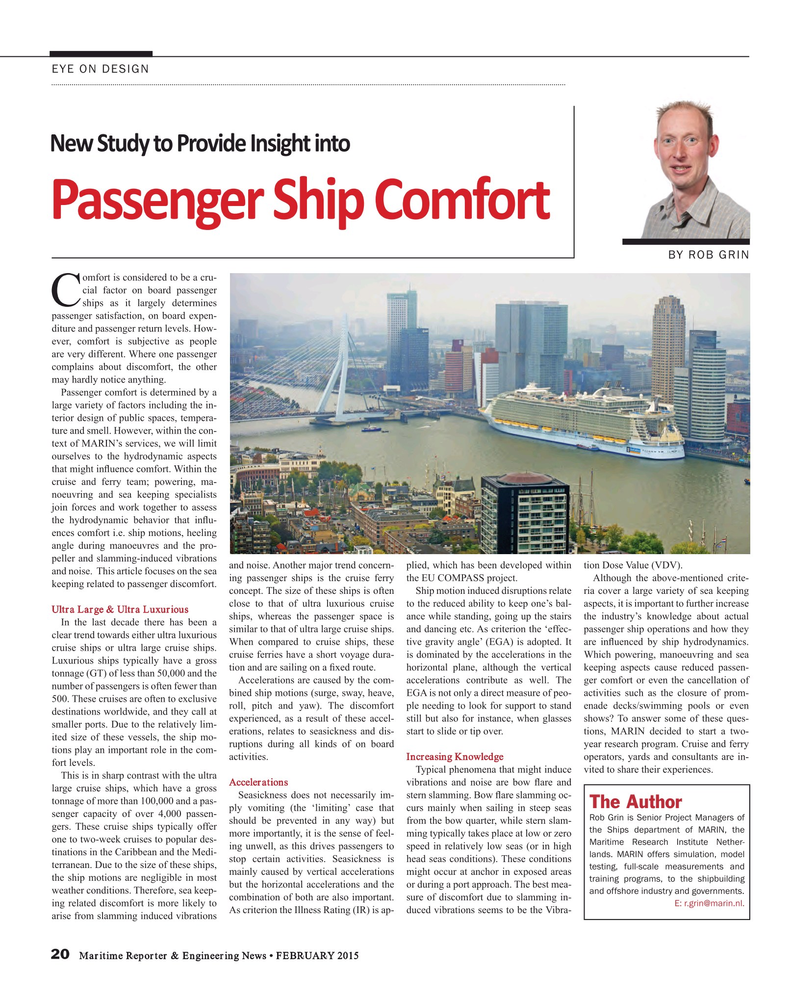
Page 20: of Maritime Reporter Magazine (February 2015)
Cruise Shipping Edition
Read this page in Pdf, Flash or Html5 edition of February 2015 Maritime Reporter Magazine
EYE ON DESIGN
New Study to Provide Insight into
Passenger Ship Comfort
BY ROB GRIN omfort is considered to be a cru- cial factor on board passenger ships as it largely determines
C passenger satisfaction, on board expen- diture and passenger return levels. How- ever, comfort is subjective as people are very different. Where one passenger complains about discomfort, the other may hardly notice anything.
Passenger comfort is determined by a large variety of factors including the in- terior design of public spaces, tempera- ture and smell. However, within the con- text of MARIN’s services, we will limit ourselves to the hydrodynamic aspects that might in? uence comfort. Within the cruise and ferry team; powering, ma- noeuvring and sea keeping specialists join forces and work together to assess the hydrodynamic behavior that in? u- ences comfort i.e. ship motions, heeling angle during manoeuvres and the pro- peller and slamming-induced vibrations and noise. Another major trend concern- plied, which has been developed within tion Dose Value (VDV). and noise. This article focuses on the sea ing passenger ships is the cruise ferry the EU COMPASS project. Although the above-mentioned crite- keeping related to passenger discomfort. concept. The size of these ships is often Ship motion induced disruptions relate ria cover a large variety of sea keeping close to that of ultra luxurious cruise to the reduced ability to keep one’s bal- aspects, it is important to further increase
Ultra Large & Ultra Luxurious
In the last decade there has been a ships, whereas the passenger space is ance while standing, going up the stairs the industry’s knowledge about actual similar to that of ultra large cruise ships. and dancing etc. As criterion the ‘effec- passenger ship operations and how they clear trend towards either ultra luxurious cruise ships or ultra large cruise ships. When compared to cruise ships, these tive gravity angle’ (EGA) is adopted. It are in? uenced by ship hydrodynamics.
Luxurious ships typically have a gross cruise ferries have a short voyage dura- is dominated by the accelerations in the Which powering, manoeuvring and sea tion and are sailing on a ? xed route. horizontal plane, although the vertical keeping aspects cause reduced passen- tonnage (GT) of less than 50,000 and the
Accelerations are caused by the com- accelerations contribute as well. The ger comfort or even the cancellation of number of passengers is often fewer than bined ship motions (surge, sway, heave, EGA is not only a direct measure of peo- activities such as the closure of prom- 500. These cruises are often to exclusive roll, pitch and yaw). The discomfort ple needing to look for support to stand enade decks/swimming pools or even destinations worldwide, and they call at experienced, as a result of these accel- still but also for instance, when glasses shows? To answer some of these ques- smaller ports. Due to the relatively lim- erations, relates to seasickness and dis- start to slide or tip over. tions, MARIN decided to start a two- ited size of these vessels, the ship mo- ruptions during all kinds of on board year research program. Cruise and ferry tions play an important role in the com- activities. Increasing Knowledge operators, yards and consultants are in- fort levels.
Typical phenomena that might induce vited to share their experiences.
This is in sharp contrast with the ultra large cruise ships, which have a gross Accelerations vibrations and noise are bow ? are and
Seasickness does not necessarily im- stern slamming. Bow ? are slamming oc- tonnage of more than 100,000 and a pas-
The Author ply vomiting (the ‘limiting’ case that curs mainly when sailing in steep seas senger capacity of over 4,000 passen-
Rob Grin is Senior Project Managers of gers. These cruise ships typically offer should be prevented in any way) but from the bow quarter, while stern slam- the Ships department of MARIN, the more importantly, it is the sense of feel- ming typically takes place at low or zero one to two-week cruises to popular des-
Maritime Research Institute Nether- ing unwell, as this drives passengers to speed in relatively low seas (or in high tinations in the Caribbean and the Medi- lands. MARIN offers simulation, model stop certain activities. Seasickness is head seas conditions). These conditions terranean. Due to the size of these ships, testing, full-scale measurements and mainly caused by vertical accelerations might occur at anchor in exposed areas the ship motions are negligible in most training programs, to the shipbuilding but the horizontal accelerations and the or during a port approach. The best mea- weather conditions. Therefore, sea keep- and offshore industry and governments. combination of both are also important. sure of discomfort due to slamming in-
E: [email protected]. ing related discomfort is more likely to
As criterion the Illness Rating (IR) is ap- duced vibrations seems to be the Vibra- arise from slamming induced vibrations 20 Maritime Reporter & Engineering News • FEBRUARY 2015
MR #2 (18-25).indd 20 MR #2 (18-25).indd 20 2/6/2015 9:17:26 AM2/6/2015 9:17:26 AM

 19
19

 21
21
